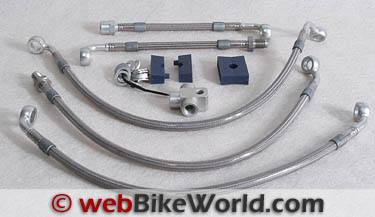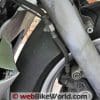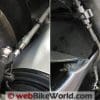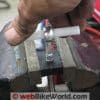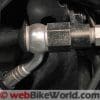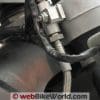We bring all of our senses to task when riding a motorcycle — with the possible exception of taste! — to operate the machines below us and maintain a certain level of safety.
It’s as if we become part of that machine in some manner; there’s a constant flow of feedback in both directions via touch, sound and sight.
This is one of the beauties of motorcycle riding for me and, I’m sure, for you.
The flow of communication between the top half and the bottom half of mind and machine is the “feeling” of what the bike is telling you when manipulating the controls for cornering, braking, sliding and the rest.
Fortunately, there are various product upgrades that can enhance these feelings of tactile communication.
One of these improvements is to replace the stock brake flex hoses with stainless steel braided brake hoses (often referred to as “lines”).
You’ll often find stainless steel brake lines as standard fitment on high-end motorcycles, but I have to admit, having never tried them, I was a little skeptical about the purported improvements they might produce.
Stainless Steel Brake Lines for Motorcycles
I understand the idea behind the construction of stainless steel brake lines. Ordinary stock brake hoses use a thick rubber/neoprene jacket with a cloth weave to surround, reinforce and protect the inner hose that actually caries the brake fluid. But these hoses can degrade over time and from exposure to the elements, especially sunlight.
As an Automotive Technician for over 40 years, I know that brake inspections included checking the flex hoses, especially on the older cars, and keeping an eye out for any cracking in the rubber outer housing. Rubber compounds have come a long way over the years, but on occasion we would find lines that had cracks deep enough where we could see the fabric cords inside. Not a good thing!
In comparison, stainless steel brake hoses use a woven stainless steel braid around the inner tube. This woven braiding is far stronger than its rubber clad relative and prevents the inner line from any expansion under high pressure demands, i.e., strong braking.
Any expansion of the inner line can result in a soft or spongy brake lever or pedal which can affect your ability to brake with control. Instead of the hydraulic brake fluid pressure acting solely to press the brake pads against the rotors, some of that pressure is being “consumed” in the expansion of the inner line.
Could they really make that big of a difference? Would the change in braking performance justify the cost? Would I be able to feel the difference?
Those were some reasons I used to delay this upgrade for many years. Besides, I felt the stock braking and feedback on both of my BMW’s was fine as it was.
But one day, while browsing the online classifieds, I happened upon a set of Spiegler stainless steel brake lines that would fit my 2002 R1150GS. It seems that BMW made a mid-year change in the braking system, or something like that, and the poor chap had ordered the wrong set. He was unable to return them and was offering them at a price that was just “too good to pass up”. For once, I beat everyone else to the punch and secured the deal!
First off, I have to admit that I had little to no experience with stainless steel brake lines, their construction or the various brands that are available prior to this installation and review. I chose to buy this set of Spiegler stainless steel brake lines because of brand name recognition but mostly because the opportunity was available.
It was after the installation and during the research for this review that I happened across some, shall we say, “differences in opinions” as to what metals should, or should not be, used for the brake line fittings.
With that in mind, it is my intent only to briefly describe a typical installation process and to illustrate that this is a project that can be done by a home mechanic. I’ll also briefly describe some of the differences that resulted from the installation of a set of stainless steel brake lines versus the stock OEM rubber brake hoses.
I’d rather not get into a discussion on possible advantages or disadvantages of various brands; for that, I advise readers to visit the various manufacturers’ websites and make their own informed choice of which brand to purchase.
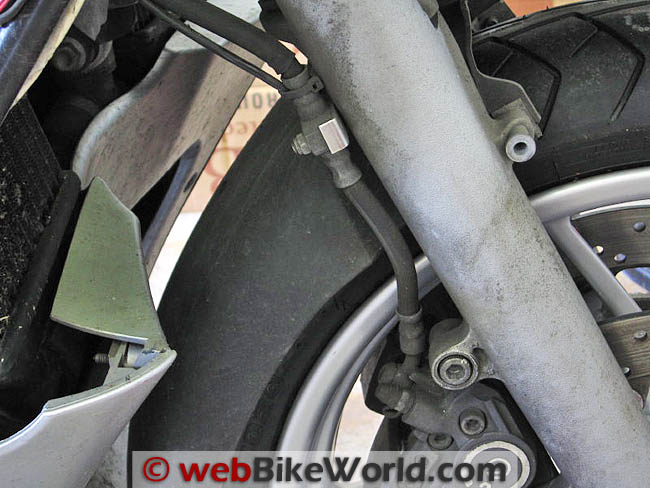
Brake Line Installation
So my money was sent and the brake lines arrived promptly in the original box with all the included parts to replace all of the rubber flex hoses for both front and rear brakes on my BMW R1150GS (report), along with new aluminum crush washers, fittings and everything else that was required.
Coincidentally, the GS was due for its annual brake fluid flush, so the timing was perfect.
One of the things I noticed right off was how much smaller the outside diameter of the stainless steel hoses were compared to the OEM hoses.
Stainless steel brake hose construction seems to be fairly consistent in that a center core “tube” of PTFE Teflon, which contains the brake fluid, is surrounded by a stainless steel braiding which prevents any expansion of the inner tubing.
These two components are surrounded and sealed in a PVC covering, available in a wide variety of colors from most manufactures, to protect them from the elements. These are swaged (crimped) onto the end fittings, which brings us to the conflict of opinion.
The set manufactured by Spiegler came with aluminum fittings and crush washers. But according to another manufacturer,HEL Performance (Hose-Equip Limited), aluminum should never be used because doing so promotes galvanic corrosion.
Without getting too deep into the chemistry, galvanic corrosion occurs whenever two dissimilar metals (aluminum fittings, steel banjo bolts) are in contact with one another, with an electrolyte present (water and a little salt?), resulting in one of the metals (usually the softer) corroding faster than the other.
How quickly this is going to occur on a set of stainless steel brake lines with aluminum fittings I have no idea (I will keep a close eye on this, though), but apparently HEL feels it is enough of a concern that all of their lines are made with stainless steel fittings. Included in their kits are stainless steel banjo bolts with copper crush washers.
[UPDATE: See the comments from B.W. below for a clarification of this issue.]It’s worth noting that both Spiegler and HEL brake lines are DOT compliant and both companies provide a lifetime warranty on their stainless steel brake lines.
It has been mentioned on this site before that much care must be taken when working on the brake system, especially when brake fluid is involved, but is worth repeating.
If allowed to come in contact with any surface for anything more than a few nano-seconds it can frost, dull or strip the paint, clear-coat or finish right off of whatever surface it contacts! This includes plastics. (Believe me when I say, “been there, done that”). (Editor’s Note: I keep a spray bottle of Glass Plus and a roll of paper towels handy for quick clean-ups and wipe-downs, just in case.)
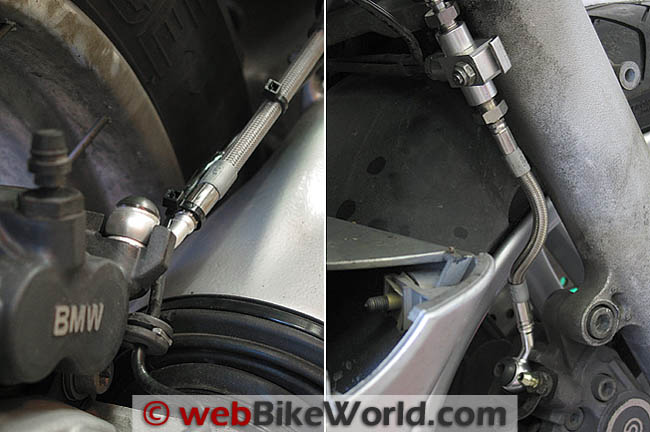
The painted areas can be covered with aluminum foil, but I opt for old towels folded over 2 or 3 times and if necessary, taped in place. Cleanliness is imperative!
So take the time to clean your tools, the entire brake reservoir, fittings at each caliper along with your hands before removing the reservoir cover/cap or loosening any fittings. You don’t want to risk the chance of allowing any dirt, grime or grit entering the hydraulic system. Even a tiny piece of dirt can raise havoc in a brake system!
Before loosening anything, the new lines were compared in length to the old ones, just to make sure they were close to being the correct length and had fittings, with the proper orientation, installed.
Brake Bleeding Cautions
Never reuse brake fluid and always use new brake fluid from an unopened container!
One reason is because brake fluid is hygroscopic, in that it readily absorbs moisture from the atmosphere which will contaminate the fluid. So do yourself, and your bike, a favor and buy fresh fluid each time in small containers.
Also, do not allow any other products, especially anything with petroleum distillates, to come in contact with brake fluid.
Avoid cross contamination by keeping any tools that are used to handle brake fluid for that task only!
Care must be taken not to introduce any dirt into the new lines either. A piece of tape over each end can prevent this from happening.
Everything looked good, so it was time to “Git-R-Dun” (Note: I routinely flush the brake systems on both bikes every year).
Using an old hypodermic with no needle, that I use only to extract brake fluid, I was able to remove almost the entire contents of the reservoir.
A piece of tubing was attached to each brake caliper bleed screw with the other end stuck a container that I use only when bleeding brakes. The bleed screws were opened and left to gravity bleed while I went to refill my coffee cup.
With towels in place around brake calipers, master-cylinders and transition points on the frame, the old lines were removed. Savvy readers may notice that there are two different bikes in the pictures; I’ll explain why later.
The new lines were laid out alongside the old ones to ensure proper orientation, loosely assembled and then installed in their appropriate locations. Amazingly enough, out of two complete kits, only one fitting needed to be tweaked a smidgeon on its line for proper alignment.
Should a fitting need to be rotated on its line, this is accomplished by clamping the end of the hydraulic line where it is crimped between the included blocks in a vise which is tightened until the blocks distort in appearance. The fitting can then be rotated as needed with the included plastic dowel (photo below).
The front lines went on with no problems other than to spread the anchor bracket a little on the right fork to accept the new, aluminum 3-way junction. It was tight getting the fittings attached to the master cylinders themselves.
Cutting a 5mm Allen wrench shorter made it possible to loosen and tighten the banjo bolt at the master cylinder without removing the hand guards on the GS.
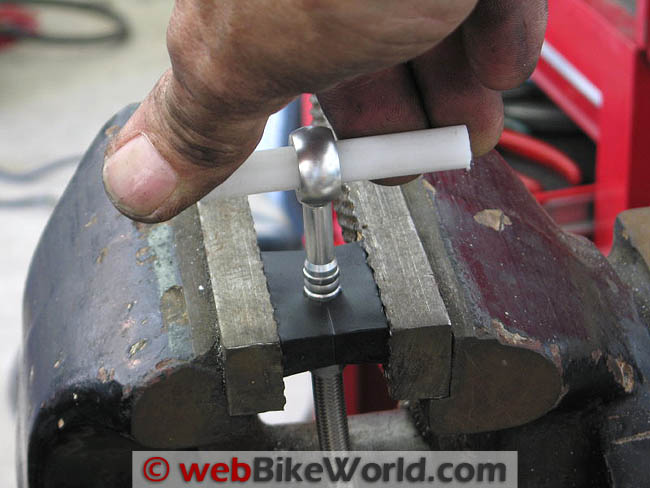
Rear Brake Lines
I encountered the same situation on the rear brakes of both bikes. The supplied line that attaches to the rear caliper was just a little bit too short. I’m talking just a couple millimeters or so.
This was with the bike on the center-stand which places the rear suspension at its fully extended position — had the bike not been on the center stand, I would have missed this condition entirely. I could have made it fit, but this would have the line under tension every time the suspension reached maximum extension, which is rare on the road, but I felt could put one heck of a strain on the entire line.
I was able to reposition the union where the forward fitting is attached rearward enough so the line could be connected tension free. As I said, this was the case on both bikes.
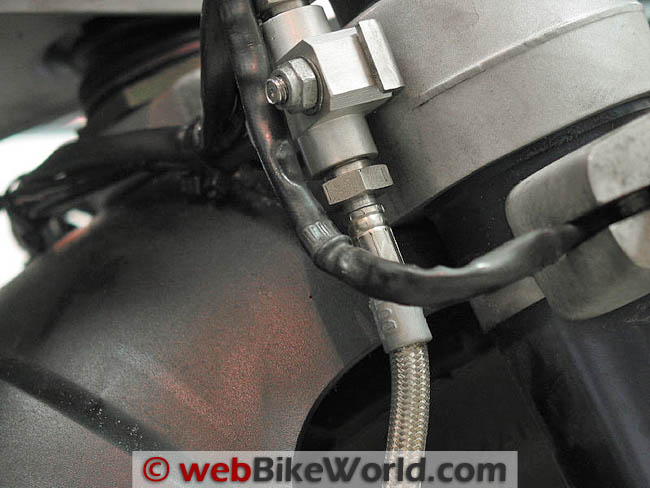
Bleeding the Brakes
Note: More on motorcycle brake bleeding in the wBW article on bleeding brakes using an Actron vacuum pump and theEZE Bleeder review.
With the lines installed it was simply a matter of bleeding the brake system. For this I use an air pressure vacuum bleeder set up, although there are a bazillion different ways to do it.
With this method I simply maintain the fluid level in the reservoir as the bleeder pulls the air and fluid through the system. I should note that it is important to follow the manufacturer’s instructions for reservoir positioning when bleeding, if there are any. I had a heck of a time getting the air out of the front brake system on the BMW K1200LT.
That was because I had the front tire locked in the straight ahead position which puts the brake master cylinder at a position that apparently traps some air.
According the the instructions from BMW, you’re supposed to loosen and rotate the handgrip assembly (not a 5-minute job) in such a manner that levels the master cylinder when bleeding the front brakes.
In the past I’ve found that simply turning the handlebars to full left lock does the same, but since the bike was on the lift I couldn’t turn them far enough and it made a difference. I could not get a solid lever despite more than sufficient bleeding. It finally occurred to me that the problem was the off-level master cylinder but not until after going over every line and fitting a dozen times or more.
With that resolved it was evaluation time. Right off I noticed a change in the front brake lever feel just with the bike sitting still. It had a noticeably firmer (hard) feel and seemed to apply the brakes a bit sooner.
On the road the front brake engagement point had a more positive feel with no “squish”. Feedback was improved too. Changes in the rear braking were harder to detect than the front, but I did have a good firm pedal.
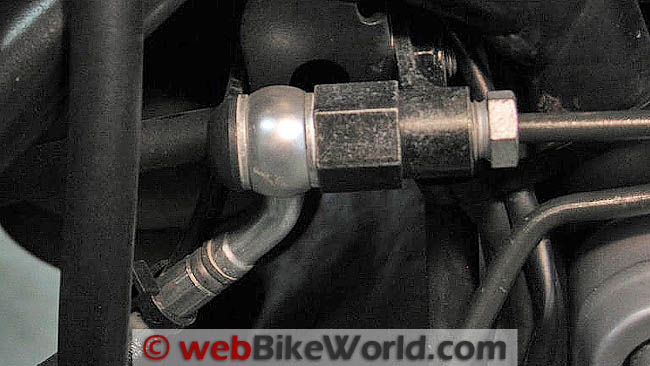
Conclusion
After everything is installed, all you need to do next is bleed the brake lines. See the wBW article on bleeding brakes using an Actron vacuum pump and the EZE Bleeder review to learn how to do this.
Overall, I’m very pleased with the improvements in the brakes. The brakes seem more responsive and I believe I have a better feel, and thus better control, of the braking action regardless of effort, especially during heavy/emergency braking.
Controlled braking is such a vital element (and skill) in riding motorcycles, but is often over looked by some riders.
I think the time and money invested to replace all of the OEM rubber flex hoses with stainless steel lines was well spent. I felt strongly enough about the improvements on my 2002 BMW R1150GS that I ordered a set of Spiegler stainless steel brake lines for my 2000 BMW K1200LTC also.
You can even add a little bling to your bike if you’re so inclined with the wide array of colors available in lines and fittings.
My only gripe about the Spiegler stainless steel brake lines is that the rear line on both bikes was too short and required bending a bracket to ease the tension on the ends when the suspension is fully extended. You can believe that I will be keeping a close eye out for any corrosion and if detected I will report back.
I leave it up to the reader to decide which brand to purchase. Complete (front & rear) kit available from Spiegler for the GS for $217.95 MSRP. A front brake line set from HEL is $196.02 and a rear brake line set from HEL is $49.00.
▪ Motorcycle Product Reviews
▪ Maintenance and Repair Articles
Owner Comments and Feedback
See details on submitting comments.
From “S.G.” (April 2014): “A comment regarding the R1150GS Spiegler brake line installation: the rear line appears too short because (as your reviewer also observed) the new lines and fittings are smaller diameter than the original ones. With the Spiegler rear line banjos rotated fully against the end stops the line points a bit sideways at both ends, and is a bit short when the suspension is fully unloaded (like on the center stand, or after a bump in the road).
After complaining to Spiegler and receiving a longer line (free of charge), which then had too much slack, I finally discovered that holding a small shim (maybe 2 mm thick) between banjo and rotation end stop when tightening the banjo bolt aligned the line straight at each end. The Spiegler rear line is then of sufficient length and no longer gets stretched when the suspension is fully unloaded.”
From “D.E.” (July 2012): “Dirty little secret 1 – All bike manufacturers require rubber brake hose replacement every 4 years; braided stainless steel hoses are good for the life of the cycle. If you intend to keep your cycle past the 4-year point (or want top price when selling it), switching to braided stainless steel hoses can make economic sense as well as improved brake performance.
(Also) Dirty little secret 2 – All bike manufacturers require the rubber seals in both the master cylinder and calipers to be replaced every 2 years.
Editor’s Reply: Not sure about “All bike manufacturers”, because I haven’t read the owner’s manuals for every motorcycle made.
I just checked, my Ducati Multistrada 620 (blog) owner’s manual and the Suzuki DR650 (blog) owner’s manual both recommend changing brake hoses every 4 years but say nothing about seals.”
From “R.L.” (04/11): “I installed braided lines on my 1979 Harley a couple years ago. The only problem I have is with a very hard front lever with little or no free lever play. The brakes work fine, however, a little more free lever play would be nice.”
From “B.W.” (04/11): “There’s a lot of incorrect information in your article in stainless brake lines, especially in the comments regarding aluminum brake line fittings. The topic is a lot more complex.
First, I’d suggest contacting Spiegler if you have concerns about using aluminum brake line fittings. There’s also information on their web site about this. They make aluminum fittings using alloys and anodizing treatments that are safe, and in fact their lines are DOT approved (I have no connection with Spiegler, other than being a satisfied customer).
[Editor’s Note: Here’s the Spiegler FAQ on brake line fitting corrosion. It reads: “Spiegler uses the most modern technology, which includes anodized aluminum fittings that will not corrode. And we have DOT and TUV certification to prove it. With Spiegler’s patented designs, we guarantee the entire brake line for life (Guaranteed for the life of original owner and the original motorcycle).”]There are generic aluminum fittings out there that will corrode in street use, and these are sold “for race use only”. That doesn’t keep people from trying to use them to build street brake lines, but it does explain why some people might believe that all aluminum fittings will corrode.
In any case, screwed-together brake lines are not technically street-legal no matter what material they’re made from.
Secondly, both the author and the commenters seem to have forgotten that brake calipers are made from aluminum. Brake crush washers are commonly aluminum or copper, but all OEMs I’ve seen use aluminum crush washers with steel banjo bolts (most OEM banjos have a chrome coating to deter corrosion).
The fears regarding galvanic corrosion between aluminum fittings and steel banjo bolts seem a bit silly when you consider that the entire caliper is aluminum.
Thirdly, everyone should bone up a bit on some basic metallurgy. The potential for galvanic corrosion is actually higher between aluminum and stainless steel than between aluminum and “regular” steel. There are a lot of variations between the various alloys of aluminum and stainless steel (so you can see that it’s important to choose alloys wisely), but you can see in this table that, for example, a 316 stainless (very common stainless alloy) banjo bolt or fitting might be a bad idea.
Some varieties of stainless are much better in this regard (more here). That’s not to say that stainless fittings are a bad idea at all — depending on the alloy they’re made from, the galvanic effects can be minimized, and in any case the crush washers help isolate the fittings.
In the end, if you install brake lines made with crimped, DOT-approved fittings from a reputable maker (Spiegler, Goodridge, Paragon, and many others), they’ll safely last the lifetime of the bike no matter what they’re made from. If they’re screwed together in the back of the local cycle shop, or in your garage from generic or “race only” fittings, well, things may turn out differently.”
Chris’ Response: A few notes: I tried contacting Spiegler, but my e-mails went un-answered. I noted in the article that SS brake lines from both manufacturers were DOT compliant (Note: DOT does not test brake lines, they only set the standards). Both companies mentioned supply lifetime warranties on their brake lines.
I did not mean to imply that aluminum fittings were unsafe, only that some of the other manufacturers of SS brake lines have said this and also that they used SS fittings because of potential corrosion issues.
Motorcycle owners should research the corrosion issue further before making a purchase.
From “A.S.” (04/11): “I installed stainless brake lines on the front of bike approx. 2 years ago. I have forgotten the brand. Since the lower fittings were not aluminum I assumed stainless – stupid me! The fittings are now entirely rusted. Be careful.”
From “R.D.” (04/11): “Just to say that I’ve had a set of alumin(i)um brake line end fittings (specifically the nut around the banjo fitting union) fall apart while washing my bike. They looked fine until I disturbed them with a sponge. I’d strongly caution against their use on a bike used on the road, especially if it is used when there is road salt around.”


